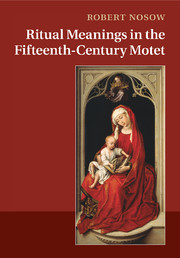Description
Ritual Meanings in the Fifteenth-Century Motet
Author: Nosow Robert
The first large-scale study of how fifteenth-century motets were used across Western Europe, dispelling the mysteries surrounding these outstanding works.
Language: EnglishApproximative price 32.87 €
In Print (Delivery period: 14 days).
Add to cart
Ritual Meanings in the Fifteenth-Century Motet
Publication date: 02-2017
Support: Print on demand
Publication date: 02-2017
Support: Print on demand
Approximative price 103.04 €
In Print (Delivery period: 14 days).
Add to cart
Ritual meanings in the fifteenth-century motet
Publication date: 02-2012
292 p. · 17x24.4 cm · Hardback
Publication date: 02-2012
292 p. · 17x24.4 cm · Hardback
Description
/li>Contents
/li>Biography
/li>
The first full-length study of how motets were used and performed in the fifteenth century, this book dispels the mystery surrounding these outstanding works of vocal polyphony. It covers four areas of intense compositional activity: England, the Veneto, Bruges and Cambrai, with reference to the works of Dunstaple, Forest, Ciconia, Grenon and Du Fay. In every documented instance, motets functioned as ceremonial vehicles, whether voiced in procession through the streets of a city or the chapel of a king, at the guild chapel of a parish church or the high altar of a cathedral. The motet was an entirely vocal genre that changed radically during the period from 1400 to 1475. Robert Nosow outlines the motet's social history, demonstrating how the incorporation of different texts, musical dialects, cantus firmus materials and melodic styles represents an important key to the evolution of the genre, and its adaptability to widely variant ritual circumstances.
Introduction; 1. Motets in the chronicles of Henry V; 2. The motet as ritual; 3. Processions in the Veneto; 4. The motet as ritual embassy; 5. Motets for the citizens of Bruges; 6. Contemplation; 7. The canons of Cambrai; 8. The dialogic motet; Appendix A. Accounts of Santa Maria dei Battuti; Appendix B. Foundations and charters at Bruges; Appendix C. Foundations at Cambrai cathedral.
Robert Nosow has published widely on fifteenth-century Latin polyphony and the relationship of written and oral traditions in the performance of Italian poetry. His writing has appeared in many publications including The New Grove, the Journal of Musicology, Early Music History and Musical Quarterly. He also edited the first scholarly edition of the three 'Concertos for Violoncello' of C. P. E. Bach.
© 2024 LAVOISIER S.A.S.





